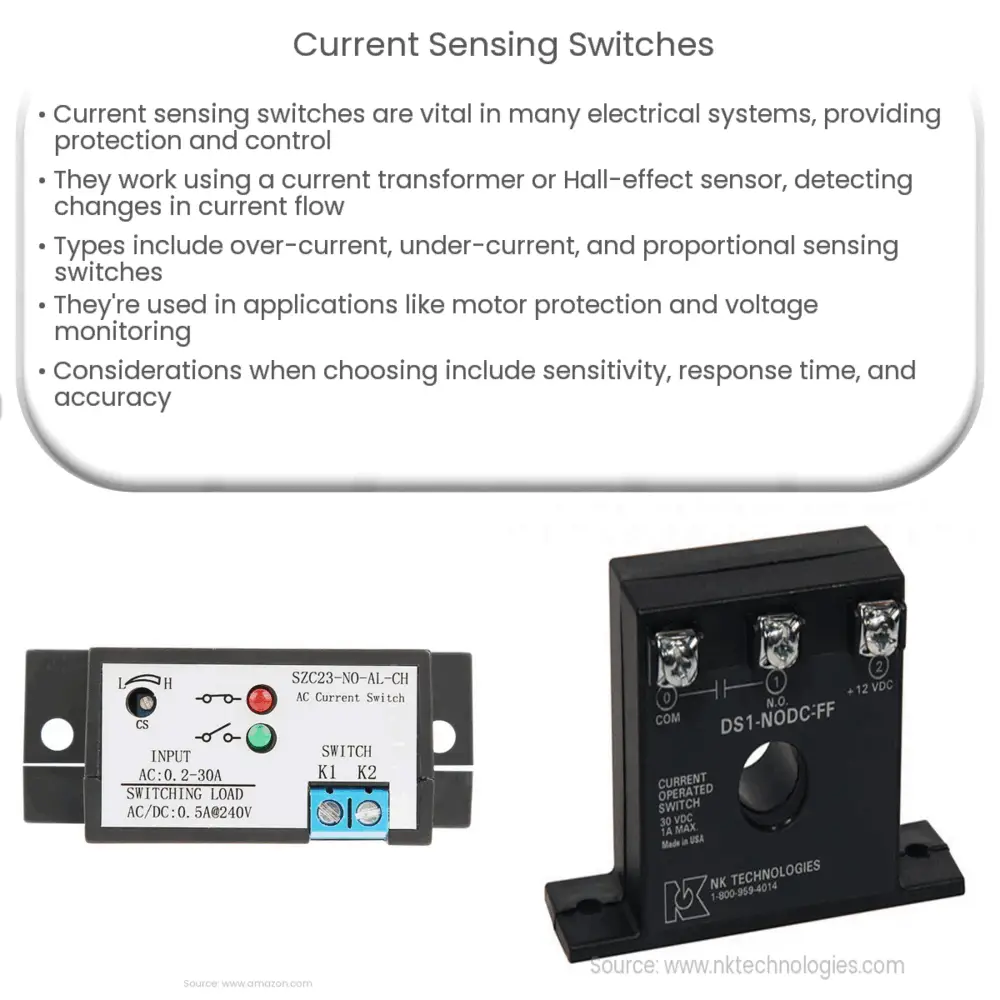Explore the crucial role, types, and applications of current sensing switches, along with key factors for selecting the right switch.

Introduction to Current Sensing Switches
Current sensing switches play an integral role in many electrical and electronic systems. These devices are designed to monitor the flow of current through a wire, and turn on or off other devices in response to that flow. They can function as protection mechanisms to prevent damage from excess current, or as part of control systems that require accurate monitoring of electrical flow.
Working Principle
At the heart of a current sensing switch is a current transformer or Hall-effect sensor, which senses the current flowing through a wire without direct electrical contact. When the sensed current reaches a pre-set level, the switch changes state, either turning on or off depending on its configuration. The switch’s state change can then be used to control other devices or systems.
Types of Current Sensing Switches
- Over-current sensing switches: These types of switches are designed to sense when the current flow exceeds a certain threshold. They are typically used in protective applications where an over-current condition could result in damage to equipment or systems. An example would be circuit breakers in residential or industrial applications.
- Under-current sensing switches: Under-current switches detect when the current drops below a certain level. These switches are used in applications where a drop in current could indicate a problem, such as a failing motor or a disconnected load.
- Proportional current sensing switches: These switches produce an output that is proportional to the current flowing through the sensed wire. They are often used in applications that require continuous monitoring and control of electrical systems.
Applications of Current Sensing Switches
Current sensing switches are found in a variety of applications due to their versatility and crucial role in system protection and control. Some common applications include: motor protection, battery management, power supply monitoring, and over/under voltage protection.
For instance, in motor protection, these switches can help to prevent motor burn-out by detecting abnormal current conditions, such as an overload or under-load situation. When such a condition is detected, the switch can trigger a control system to take appropriate action, such as shutting down the motor or adjusting the load.
Advantages and Disadvantages
Current sensing switches offer numerous advantages, such as providing a non-invasive means of monitoring current, contributing to system safety, and enabling sophisticated control strategies. However, they are not without their drawbacks. Considerations must be made for the switch’s accuracy, response time, and the potential for false triggering.
Factors to Consider when Choosing a Current Sensing Switch
There are a number of factors that should be considered when choosing a current sensing switch for a particular application. These include:
- Sensitivity: The sensitivity of a current sensing switch determines how small a current change it can detect. High sensitivity switches can detect very small changes in current, which may be necessary for certain applications.
- Response Time: This is the time it takes for the switch to react to a change in current. A quicker response time may be crucial in applications where rapid changes in current can lead to serious problems or damage.
- Accuracy: The accuracy of a current sensing switch is a measure of how closely the switch’s output corresponds to the actual current. High accuracy is important in applications where precise current control or monitoring is required.
Conclusion
In conclusion, current sensing switches play a vital role in many electrical and electronic systems, providing essential protection and control capabilities. By monitoring the flow of current, they can trigger appropriate responses when abnormal conditions occur, thereby preventing potential damage and ensuring the safe and effective operation of systems. When selecting a current sensing switch, sensitivity, response time, and accuracy are key considerations to ensure that it meets the requirements of the specific application.
While current sensing switches have their advantages, including non-invasive current monitoring, improved system safety, and enabling sophisticated control strategies, they also have certain limitations such as the potential for false triggering. Therefore, it’s crucial to understand the working principle, types, and applications of these switches, as well as the various factors that should be considered when selecting a suitable switch for a particular application.

